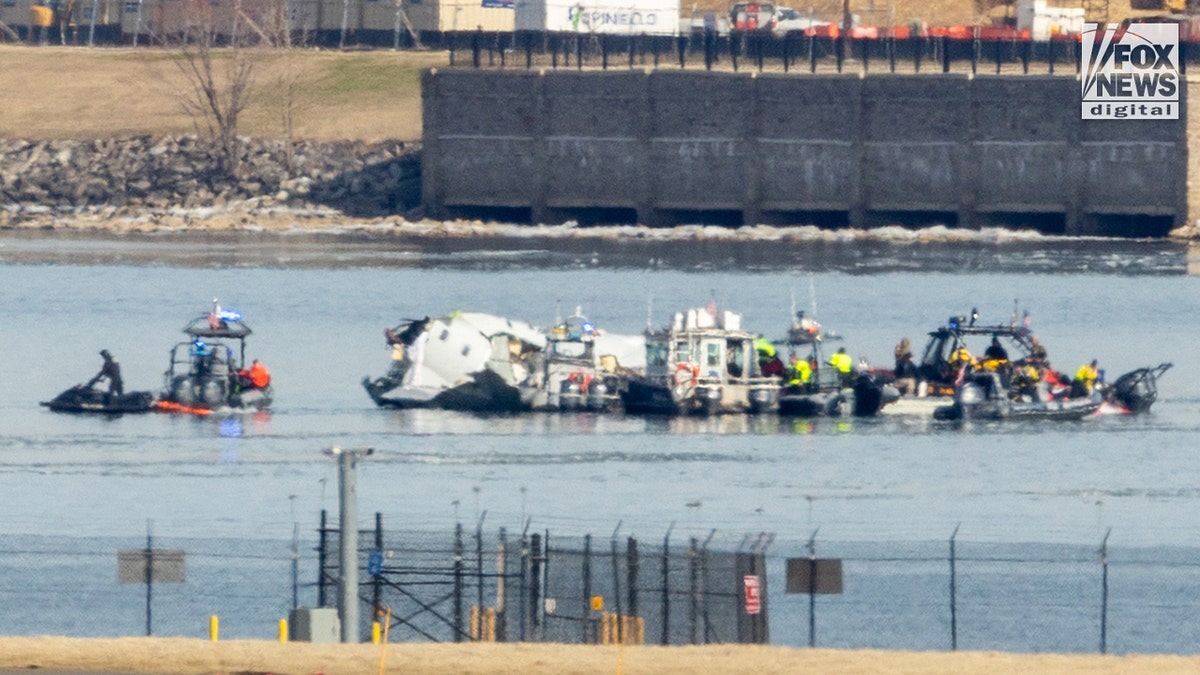Despite several aviation disasters across the country in recent weeks and growing concerns about the safety of flying, an expert says air travelers have nothing to fear.
The United States experienced three fatal plane crashes in just eight days, beginning with the deadliest aviation accident in America in the last 24 years.
An Army Black Hawk helicopter collided midair with an American Airlines passenger plane near Washington, D.C., on Jan. 29, killing all 67 passengers on both aircraft.
WHAT WE KNOW ABOUT THE VICTIMS OF THE PHILADELPHIA CRASH

Crew retrieve wreckage of American Airlines Flight 5342 from the Potomac River in Washington, D.C., Jan. 30, 2025. (Leigh Green for Fox News Digital)
Just days later, a medevac plane carrying a young girl, her mother and four crew members crashed near the Roosevelt Mall in Philadelphia, killing all those on the plane and one bystander on the ground on Jan. 31.
A commuter plane was then found wrecked off the coast of Alaska on Feb. 7, with all 10 people on board deceased, after the flight traveling from Unalakleet to Nome disappeared the day prior.
“As long as we put airplanes in the sky that have been built by and run by the hand of man, there are going to be mistakes made … but those mistakes are fewer and fewer and fewer,” Mike Boyd, an aviation consultant and the president of Boyd Group International, told Fox News Digital. “The public should be aware that the people in charge right now are trying to keep them safe. That’s the bottom line.”
The Federal Aviation Administration (FAA) lists the 10 most frequent cause factors for general aviation accidents involving the pilot:
- Inadequate preflight preparation and/or planning
- Failure to obtain and/or maintain flying speed
- Failure to maintain direction control
- Improper level off
- Failure to see and avoid objects or obstructions
- Mismanagement of fuel
- Improper in-flight decisions or planning
- Misjudgment of distance and speed
- Selection of unsuitable terrain
- Improper operation of flight controls
“This list remains relatively stable and points out the need for continued refresher training to establish a higher level of flight proficiency for all pilots,” the FAA writes.
Wreckage is seen in the Potomac River near Ronald Reagan Washington National Airport on Jan. 30. (Petty Officer 1st Class Brandon Giles/U.S. Coast Guard via AP)
Boyd said flyers “don’t need to look at 10 points” or “any of the data,” explaining that the recent aviation tragedies were a “situation where we’ve had a couple of human errors and systemic errors, and they’re fixed.”
“The events that have happened do not indicate we have a major safety problem,” he added. “The issue in Washington, the commercial airplane was doing exactly what it should have done, and we had an air traffic controller that didn’t do the job. In Philadelphia … that was a private medical airplane … that’s not a safety issue as far as flying on commercial airplanes go.”
ALASKA CREWS RECOVER REMAINS OF ALL 10 PLANE CRASH VICTIMS, AUTHORITIES SAY
First responders work the scene after a plane crash in Philadelphia on Jan. 31, 2025. (Matt Rourke/AP)
A Ronald Reagan Washington National Airport tower supervisor allegedly let another air traffic controller leave work early on the night of the D.C. collision. The FAA calls for one controller to monitor planes while another monitors helicopters.
An internal preliminary report from the FAA indicated that staffing levels at the time of the collision were “not normal for the time of day and volume of traffic.”
“We know that air traffic control confirmed with the helicopter crew that they had visual contact with the plane. Controllers then instructed the helicopter to move behind the plane,” Sen. Ted Cruz, R-Texas, who chairs the Senate Committee on Commerce, Science, and Transportation, which oversees the aviation industry, said about the collision. “However, instead of complying, the helicopter moved in front of the aircraft. The two aircraft collided midair, resulting in a catastrophic explosion.”
DC PLANE CRASH INVESTIGATORS RECOVER AMERICAN AIRLINES BLACK BOXES AFTER MIDAIR COLLISION
A commuter plane crashed off the coast of Alaska, killing all 10 people on board. (X/@USCGAlaska)
With different aircraft involved in recent aviation accidents, Boyd discussed whether commercial and general aviation vary in safety.
“Commercial airplanes are under much stricter safety rules and safety oversight than our privately owned airplanes,” he explained. “That much said, there is no indication of any major safety issues whatsoever with general aviation compared to commercial aviation.”
“The two systems are very, very different,” Boyd continued. “Commercial airplanes … may fly 2,000 hours a year, while general aviation private airplanes may fly 200 hours a year … so it’s a very different utilization, but as far as safety goes, the safety standards are quite high.”
STAFFING AT REAGAN WASHINGTON NATIONAL AIRPORT AIR CONTROL TOWER WAS ‘NOT NORMAL’ ON NIGHT OF COLLISION: FAA
Investigators work the scene on Feb. 1, the day after a small plane crashed in Philadelphia. (AP Photo/Matt Rourke)
Transportation Secretary Sean Duffy told Fox News last week that America’s skies remain the safest in the world but that many of the FAA’s systems remain “antiquated” and changes could be made to improve them.
“If it wasn’t safe, if there was an issue with air traffic controllers or staffing that couldn’t keep the system and the people safe in it, the FAA would shut it down,” he said. “We do have technologies on airplanes to keep them separated … our system does need to be upgraded.”
Boyd said that with more than half a billion people getting on airplanes every year, Americans should continue to “get on the airplane … go see grandma.”
“People should not be worried about flying,” he added. “It’s a whole lot safer than driving down the highway.”
Fox News’ Alexandra Koch contributed to this report.
https://www.foxnews.com/us/plane-crashes-spark-renewed-fear-flying-10-causes-aviation-disasters